Robot Stories #1
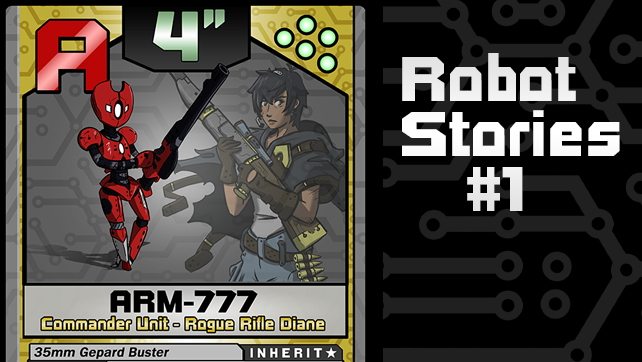
Every Card a Painting
In this series of blog posts we’d like to talk about the design and development of the cards in our original, self-published Core Set. It’s been well over a year since we’ve been printing A.E.G.I.S. on our own, and we’ve seen these cards be used by many, many players at all sorts of events. Now that we’re moving forward with a publisher, a lot of these robots will likely by retuned and rebalanced based on all of the insight we’ve received from our players. But while we do that, here’s a look at our thought process from when we made certain cards in the first place!
Putting the “A” in Variety
In our Core Set, there are 9 Assault-Class robots total, and a portion of them are Faction-Aligned (these have colored card backgrounds which prevent them from being used with other robots that have a different-colored background). We wanted to establish that there were many different roles for A-Class robots to play, and also wanted to show how robots from various factions could look and function differently from the norm.
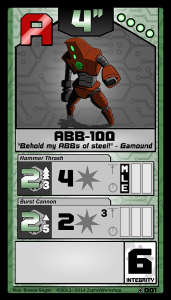 ABB-100 has a more boxy, tank-like appearance, with lower movement and higher integrity, like a G-Class. It belongs to the Great States faction, who are slow-moving in their advances but solid and built to last– like G-Class robots! The original sketches of A.E.G.I.S. had what looks like an ABB as the first-ever A-Class robot. Long ago, it was envisioned that A-Classes would look more toy-like and less strictly humanoid-with-large-head, but now we do both and everything in between. ABB-100’s amazing flavor text was added the night before our first print run by master writer Sarah Como, and it’s stayed since! ABB-100 has proven to be a powerful, simple robot that’s been great for beginning players due to its lack of complicated weapon attributes and abilities.
ABB-100 has a more boxy, tank-like appearance, with lower movement and higher integrity, like a G-Class. It belongs to the Great States faction, who are slow-moving in their advances but solid and built to last– like G-Class robots! The original sketches of A.E.G.I.S. had what looks like an ABB as the first-ever A-Class robot. Long ago, it was envisioned that A-Classes would look more toy-like and less strictly humanoid-with-large-head, but now we do both and everything in between. ABB-100’s amazing flavor text was added the night before our first print run by master writer Sarah Como, and it’s stayed since! ABB-100 has proven to be a powerful, simple robot that’s been great for beginning players due to its lack of complicated weapon attributes and abilities.
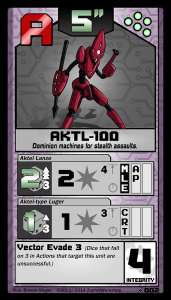 AKTL-100 is quicker than the average robot, and has the normally Intel-Class ability Vector Evade, along with more technical attacks. It’s an assassin-type robot belonging to the Iris Dominion, the shadowy faction of our world. AKTL is also the only robot in the game with a ranged melee attack. Because it is melee, it means you have to attack an enemy adjacent to you, and then it has 4 Distance and Armor Piercing to hit anything behind it. While this was a good idea from a flavor-perspective, it had a tendency to confuse some players, so moving forward we’ll very likely be reworking this robot’s lance attack to be more intuitive.
AKTL-100 is quicker than the average robot, and has the normally Intel-Class ability Vector Evade, along with more technical attacks. It’s an assassin-type robot belonging to the Iris Dominion, the shadowy faction of our world. AKTL is also the only robot in the game with a ranged melee attack. Because it is melee, it means you have to attack an enemy adjacent to you, and then it has 4 Distance and Armor Piercing to hit anything behind it. While this was a good idea from a flavor-perspective, it had a tendency to confuse some players, so moving forward we’ll very likely be reworking this robot’s lance attack to be more intuitive.
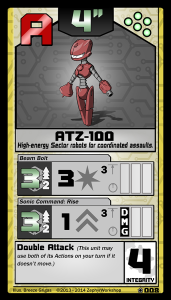 ATZ-100 belongs to the Sector Authority, and was designed to work similarly to a Support-Class robot. It has the ability to heavily damage something and help out an ally by boosting their Damage output on the same turn, in exchange for lower integrity. It’s also a more feminine robot model, sporting a pink salmon-y color and more rounded features. In play, this robot has performed to be as versatile as intended and probably won’t be changing!
ATZ-100 belongs to the Sector Authority, and was designed to work similarly to a Support-Class robot. It has the ability to heavily damage something and help out an ally by boosting their Damage output on the same turn, in exchange for lower integrity. It’s also a more feminine robot model, sporting a pink salmon-y color and more rounded features. In play, this robot has performed to be as versatile as intended and probably won’t be changing!
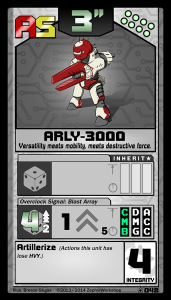 ARLY-3000 was the first AS-Class ever designed, and is currently the only one in the game. The purpose of its empty attack slot was to encourage players to utilize combine inheritors, taking your S-Class robot’s giant rail gun/laser/missiles and bringing it up for this robot to use. The ability “Artillerize” was to allow those inherited weapons to be used more aggressively, and that’s what really makes this robot partially A-Class and partially S-Class in practice. The powerful damage/accuracy boost is ARLY’s main feature. Combine inheritors are a fairly complex feature, so we’re currently mulling over removing it from the Core Set for the final release, and thus this robot’s fate is up in the air.
ARLY-3000 was the first AS-Class ever designed, and is currently the only one in the game. The purpose of its empty attack slot was to encourage players to utilize combine inheritors, taking your S-Class robot’s giant rail gun/laser/missiles and bringing it up for this robot to use. The ability “Artillerize” was to allow those inherited weapons to be used more aggressively, and that’s what really makes this robot partially A-Class and partially S-Class in practice. The powerful damage/accuracy boost is ARLY’s main feature. Combine inheritors are a fairly complex feature, so we’re currently mulling over removing it from the Core Set for the final release, and thus this robot’s fate is up in the air.
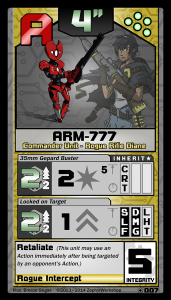
ARM-777 is our sixth Commander Unit. It’s piloted by Diane, a rogue soldier who separated herself from the Empyreal Realm. ARM-777 is the only neutral commander robot, allowing many varied strategies to be built around it.
This robot has already changed over time when compared to the first printing at BostonFIG 2013. Originally it had a much simpler design, with a single attack and the same two passive abilities. The attack was a 1-damage shot with two instances of Critical, meaning that if you ever happened to roll a pair of the right number, Diane would “boom, headshot!” something for 5 damage, whereas other times she would do 3 damage, and 80% of the time would just deal 1. The thing was, Diane is supposed to be an expert markswoman, and it made no sense for her power to be based entirely on luck.
To better match her unique persona, we went back and gave her a lock-on ability, and reduced the overall randomness in attacking, though it did increase the amount of content on the card. Diane has proven to be very powerful, but Buffs and Debuffs are the least intuitive mechanics in our game right now, and we’re always trying to do better on that front.
Rogue Intercept was a hard ability to come up with. The original pitch was that it gave all your robots Beacon, with the intention of you being able to choose your opponent’s attack targets. It was quickly shot down by our top-notch developers, however. After a lot of back and forth and a half-dozen unmemorable ideas, we came to this extremely tactical ability, where you can choose a single robot on each of your turns to be a magnet for attacks. Very similar to Ixa’s Arrest Mandate ability, Rogue Intercept’s usefulness is almost entirely reliant on the skill and planning of the player using it, which makes for a great mechanic.
Leveling Up
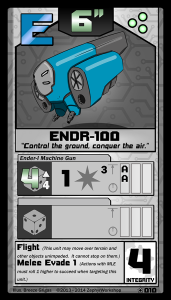
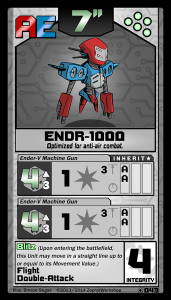
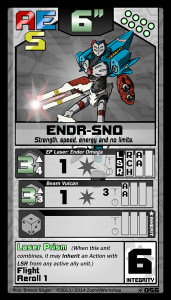
The ENDR series of robots is one of the few in our Core Set that flows nicely from level 1 to 3 in a very linear pattern, like the evolution of a Pokémon. ENDR-100 was the first E-Class robot ever designed, way back in our alpha playtest when it was just called the ‘END-100’. These days, ENDRs are defined by their single-target machine gunning attacks and overall similarity to A-Class robots, but for a number of months, ENDR-100 actually had a carpet bomb for its secondary move. We later moved the carpet bomb to its own robot, the ELL-100. Each Make having its own unique identity and skill set is important for the future of the game.
Similarly, ENDR-1000 was the first combined robot ever drafted. It’s a basic AE-Class that goes fast and hits hard. You take ENDR-100, give it two weapons and the A-Class ability ‘Double Attack’ with some more aggressive movement and bam, your enemies are done! In play, we’ve had many players say that 4 integrity seems very fragile for a combined robot, but in those same games, ENDR-1000 usually ends up being very, very powerful in terms of damage output which is what we were intending. Double-Attack requiring it to be stationary is good for balance, but moving forward we may name it something else, since “Double Attack” implies that you can use two attacks at any time.
ENDR-SNO was the first level 3 robot ever sketched out, and is currently ENDR’s ultimate form; a robot with all-around good stats and a main weapon that has A, E and S mechanics (multiple attack, anti-air and laser). Because it’s part SNO, it’s very laser-centric and its Laser Prism ability that copies lasers from your allies is one that’s intended to get better over time as we release more laser-wielding robots. The mechanic Recharge (RCH) was originally added for balance reasons and only allowed for the robot’s main laser to be fired every other turn. It was confusing and stunted game-play in most games, so moving forward we will most likely nix Recharge altogether.
The Greatest Stories Ever Told
We’ve learned a lot from our game being out in the wild, and it’s definitely helping us make the best robot game ever!
Do you have feedback on any specific cards? Make sure to drop us some comments at zephyrworkshop@gmail.com!
Fight and Unite!
